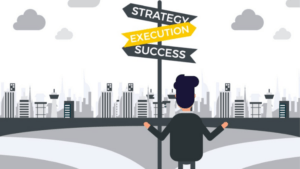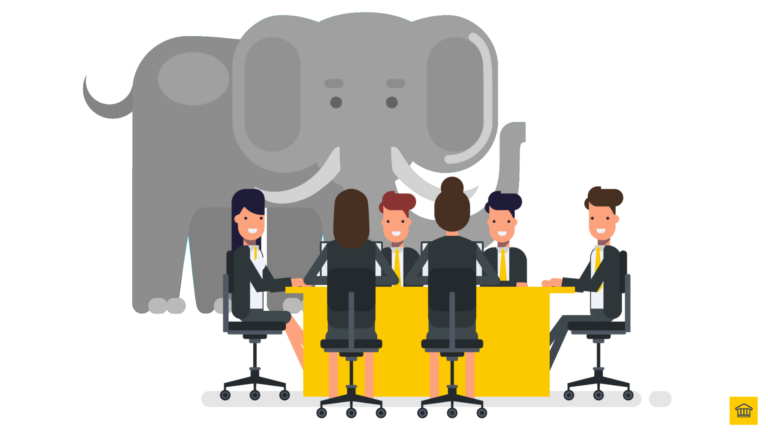Design-alone in business transformation is as much value as driving a new car out of a showroom with no petrol. Zero. In this article today, we will explain how design-alone will not help you with business transformation.
If you want to transform your business or help your clients transform theirs and want to do it quicker, with less resistance, then this is for you.
Lets get started!
What is Design?
In terms of Business Transformation, ‘design’ has two parts.
The first part is – ‘design’ is an outcome. That outcome is the ‘design’ of the future ‘design’ of the Organisation aka the Target Operating Model (TOM).
This future TOM is what enables businesses to achieve their vision. How the business does that, is ultimately through executing their business strategy – that is, their People-strategy, Process-strategy, Technology-strategy, and Data-strategy. These ‘strategies’ are the levers available to the Organisation that it can pull or leverage to achieve its Vision.
This ‘design’ aka TOM is ‘how the Organisation is setup, structured and how it operates’, to enable Organisations to achieve its Vision in the most efficient and effective way.
The second part is Process.
Now, the second part. This is the part that most companies, consultancies and consultants go wrong. This addresses the question – ‘How do you get to a TOM’? Well, how you get to the TOM is via a process, the Design Process to be exact.
The TOM doesn’t just appear out of thin air. There is a process to it. A 6-step ‘design process’ actually (to learn more about the 6-step process, go here). There the market is going wrong, they are starting the ‘design’ at the end of the process, Step 5-Design.
When you start the ‘design’ at Step 5, you are effectively addressing the symptoms of the problems and issues the organisation is facing. It works well while the consultants are still in the building, but when they have left, it all falls apart.
That is where the expression came from when the Client complains after the Consultants have left and the ‘solution’ they delivered starts to break “well, it was working when we gave it to you”.
Don’t fall for that trap. Do the work. Follow the process.
If you done it right, you would have designed the TOM, using the ins-cope and prioritized changes (i.e. the prioritized Business Changes and Technology Enablers) to design the Target Operating Model (TOM).
Not only have you then designed the TOM to be the most efficient and effective version of the Organisation, set up and structured to achieve its strategic Vision through the execution of its people, process, technology and data strategy, but also enabled it to realise the operational vision – the Business Benefits.
So what does that mean? It means when you design the TOM, you have to go through the first 4 steps in order to get to design. That is how you go from the current operating model to the future operating model. Through the design process.
The design process doesn’t just develop the ‘design’ of the Target Operating Model (TOM), it also manages the implementation of the ‘physical’ TOM and Business Architecture. This is the part that is missing in Business Transformation today. This is where the ‘design-alone’ is useless part comes in. Your TOM is useless, if you can’t implement it (or at least show the pragmatic route or road map to how you would implement it).

Why design is important
Design is important because that is your blueprint. Ever seen a building built without a plan? No, neither has a business. Design however, is not worth the paper (or screen) it is written on, if it hasnt been tested.
So that raises the question is – ‘How do you test it?’. Well, how you test it – is in an agile fashion, and that is via a pilot or Minimum Viable Product (MVP). What that means is that you test it on a small scale, get feedback and iterate until it’s ‘good enough’ to develop the ‘full version, and implement.
Up until testing, investing in ‘design’ (without testing) is the same spinning wheels on a stationary bike – going no where, fast. Its literally throwing your money and bodies at the problem, but still, your transformation is not going any faster.
If you are facing this, it means you are suffering from Marketecture. When you are a victim of Markecteture you are just throwing money but there is no business transformation. There is absolutely no implementation.
If you are not familiar with the term, here’s the definition of Markecteture according to Wikipedia,
“[A marketecture] is one page, typically an informal depiction of the system’s structure and interactions. It shows the major components, and their relationships and has a few well-chosen labels and text boxes that portray the design philosophies embodied in the architecture. A marketecture is an excellent vehicle for facilitating discussion by stakeholders during design, build, review, and of course the sales process [..]”
While ‘Design’ is clearly important, if you focus too much on the design alone, you miss out on the most important element in business transformation – and thats “implementation”. If you can’t implement your ‘design’, or you ‘implement’ the design and it doesn’t result in the transformation you planned, you have failed.

Design and Business Transformation
Implementation of the design is crucial for a successful business transformation. Design starts with business capabilities. The design is explicitly based on implementing business changes (people and process) and enables (technology) that directly impacts the realization of the planned business benefits.
70% of business transformations end in failure. Any guesses where the failure becomes real? Failure becomes real – not in design, it becomes real when that design is attempted to be implemented, when the Organisation (and/or Client) can see and feel the changes.
The problem isn’t so much the design is incorrect or wrong, it is the problem in most cases, wasn’t properly identified or defined, until implementation when the physical changes in the design are implemented.
The Goal of the Design
The goal of ‘design’ is to develop the design of the TOM and oversee the implementation of the physical TOM so that it aligns with the design. To be explicitly clear – the goal of ‘design’ is not to make Blueprints for Blueprints’ sake.
The different views and aspects of the organisation are captured and documented in blueprints – usually there are two (2) versions – an ‘as-is’ of ‘current state’, and the ‘to-be’ or ‘future state’.
This is the other mistake Organisations, Consultancies and Consultants make – they create ‘to-be’ versions of all blueprints. Only by exception when designing the TOM will it be and is it necessary to create ‘To Be’ versions of certain blueprints.
The situations where these exceptions occur include Merger and/or Acquisition (M&A), formation of a Joint Venture (JV), or divestment, where the structure of the Organisation has fundamentally changed, requiring the ‘as-is’ and ‘to-be’ versions, to compare and contrast, and show the differences, so the Business Stakeholders can visually see the changes, and the need for change.
What Design Provides
In terms of process – ‘Design’ (Step 5) leads to Step 6 – Implement. Step 6- Implement is where the actual implementation of the changes (people and process) and enablers (technology) takes place.
If you havent guessed already – Step 6 Implement is actually two (2) parts – delivery of the ‘design’ of the Target Operating Model (TOM); and the implementation as the ‘physical’ Business Architecture that the TOM ‘design’ describes.
The design allows Business Transformators to work on the following aspects of the project
- Capability – Mapping
- Process – Mapping
- Impact – Mapping
- Cost-Benefit – Mapping
- Pilot – Mapping
The design process is a crucial step in the business transformation. The process of transformation has six steps. The problem is the marketplace is so focused on just design, they start the process at the end, in design. The most common cause for jumping into ‘design’ or ‘solution mode’ is there is often not a single agreed view or consensus of what the pain or the current state of the organization is.
By following the HOBA® Design Process, and starting the design with Business Capabilities, you will identify the candidates’ capabilities (people, process, technology & data) that are being changed or enhanced specifically to address the identified and prioritised stakeholder’s concerns that directly contribute to the Organisation realizing the planned business benefits.
The key to implementation is the Pilot. You have to test the candidate changes on a small scale, small in terms of cost, time, and degree of change. What that means is you test the changes on a sample of the population or one part of the overall end-to-end process, or the whole end-to-end process, but a light touch, to see the candidate changes are fit for purpose, before developing them fully and rolling them out.
Pilots follow is a lean-start-up technique, which is based on two (2) principles – ‘fail fast’, and ‘Build, Measure, Learn’. As a result, the Business gets to validate the candidate capabilities are indeed the right capabilities that will likely achieve the planned Business Benefits (and ultimately the Business Strategy) before the decision (and more costs are incurred and/or committed) for full implementation.
Thank you for reading this!
Sincerely,
Heath Gascoigne
P.S. If you want to join our Business Transformator community of 2,000+ like-minded Business Transformators, join the community on the Business Transformator Facebook Group here.
P.P.S. If you want to learn more about business transformation, check out The Business Transformation Playbook here.
For more information, visit https://www.hoba.tech











